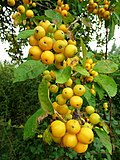| Malus orientalis | |
|---|---|
 | |
| Scientific classification | |
| Kingdom: | Plantae |
| Clade: | Tracheophytes |
| Clade: | Angiosperms |
| Clade: | Eudicots |
| Clade: | Rosids |
| Order: | Rosales |
| Family: | Rosaceae |
| Genus: | Malus |
| Species: | M. orientalis |
| Binomial name | |
| Malus orientalis | |
| Synonyms [2] | |
List
| |
Malus orientalis, the eastern crabapple or Caucasus apple, is a species of flowering plant in the family Rosaceae. It is found in Bulgaria, Turkey (including East Thrace), the Caucasus region, Iran, and Afghanistan. [2]
With its relatively large yellow fruit, it has been consumed by people for millennia, with a string of halved, dried fruit being found in a royal tomb at Ur.[ citation needed ] Drying the fruit and then rehydrating by boiling cuts the tartness. Malus orientalis contributed to the gene pool of domesticated apples, along with M. sieversii and M. sylvestris . [3] [4] [5]
